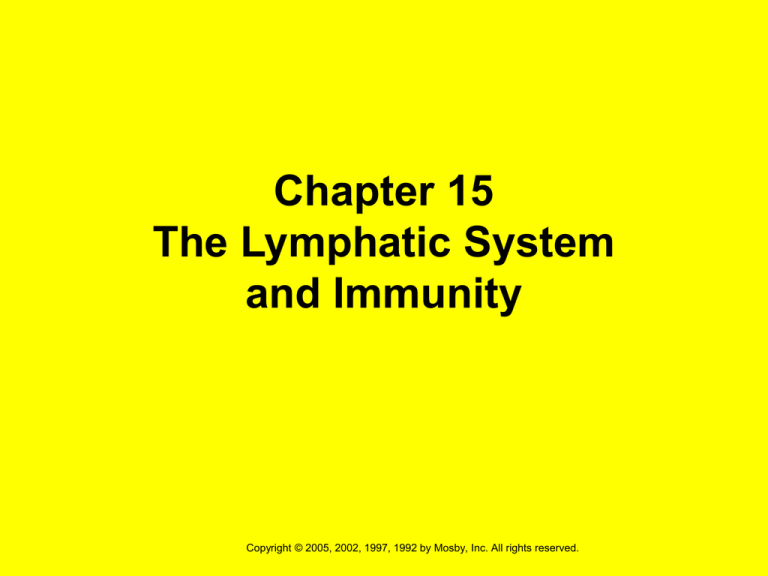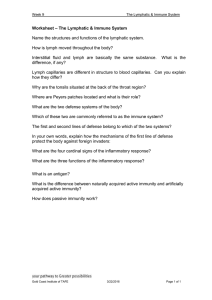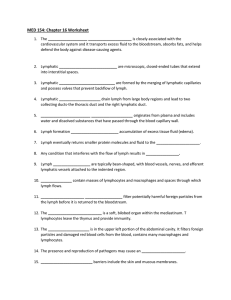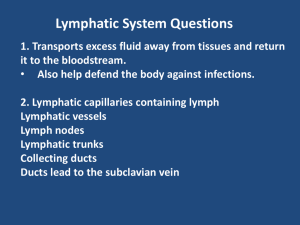
Chapter 15
The Lymphatic System
and Immunity
Copyright © 2005, 2002, 1997, 1992 by Mosby, Inc. All rights reserved.
The Lymphatic System
• Lymph—fluid in the tissue spaces that
carries protein molecules and other
substances back to the blood
Copyright © 2005, 2002, 1997, 1992 by Mosby, Inc. All rights reserved.
The Lymphatic System
• Lymphatic vessels—permit only one-way
movement of lymph
– Lymphatic capillaries—tiny blind-ended tubes
distributed in tissue spaces
• Microscopic in size
• Sheets consisting of one cell layer of simple
squamous epithelium
• Poor “fit” between adjacent cells results in porous
walls
• Called lacteals in the intestinal wall (for fat
transportation)
Copyright © 2005, 2002, 1997, 1992 by Mosby, Inc. All rights reserved.
The Lymphatic System
– Right lymphatic duct
• Drains lymph from the right upper extremity and
right side of head, neck, and upper torso
– Thoracic duct
• Largest lymphatic vessel
• Has an enlarged pouch along its course, called
cisterna chyli
• Drains lymph from about three fourths of the body
Copyright © 2005, 2002, 1997, 1992 by Mosby, Inc. All rights reserved.
The Lymphatic System
• Lymphedema—swelling (edema) of
tissues caused by blockage of lymph
vessels
– Lymphangitis—inflammation of lymph vessels,
may progress to septicemia (blood infection)
– Elephantiasis—severe lymphedema of limbs
resulting from parasite infestation of lymph
vessels
Copyright © 2005, 2002, 1997, 1992 by Mosby, Inc. All rights reserved.
The Lymphatic System
• Lymph nodes
– Filter lymph
– Located in clusters along the pathway of
lymphatic vessels
– Functions include defense and WBC
formation
– Flow of lymph: to node via several afferent
lymph vessels and drained from node by a
single efferent lymph vessel
Copyright © 2005, 2002, 1997, 1992 by Mosby, Inc. All rights reserved.
The Lymphatic System
• Lymphoma—malignant tumor of lymph
nodes
– Two types: Hodgkin disease and non-Hodgkin
lymphoma
• Thymus
– Lymphoid tissue organ located in
mediastinum
– Total weight of about 35–40 g—a little more
than an ounce
Copyright © 2005, 2002, 1997, 1992 by Mosby, Inc. All rights reserved.
The Lymphatic System
–
–
–
–
Plays a vital and central role in immunity
Produces T-lymphocytes or T cells
Secretes hormone called thymosin
Lymphoid tissue is largely replaced by fat in the
process called involution
Copyright © 2005, 2002, 1997, 1992 by Mosby, Inc. All rights reserved.
The Lymphatic System
• Tonsils
– Composed of three masses of lymphoid
tissue around the openings of the mouth and
throat
• Palatine tonsils (“the tonsils”)
• Pharyngeal tonsils (adenoids)
• Lingual tonsils
– Subject to chronic infection
– Enlargement of pharyngeal tonsils may impair
breathing
Copyright © 2005, 2002, 1997, 1992 by Mosby, Inc. All rights reserved.
The Lymphatic System
• Spleen
– Largest lymphoid organ in body
– Located in upper left quadrant of abdomen
– Often injured by trauma to abdomen
– Surgical removal called splenectomy
– Functions include phagocytosis of bacteria
and old RBCs; acts as a blood reservoir
– Splenomegaly—enlargement of the spleen
Copyright © 2005, 2002, 1997, 1992 by Mosby, Inc. All rights reserved.
The Immune System
• Protects body from pathological bacteria,
foreign tissue cells, and cancerous cells
• Made up of specialized cells and
molecules
• Nonspecific immunity
– Skin—mechanical barrier to bacteria and
other harmful agents
Copyright © 2005, 2002, 1997, 1992 by Mosby, Inc. All rights reserved.
The Immune System
– Tears and mucus—wash eyes and trap and
kill bacteria
– Inflammation attracts immune cells to site of
injury, increases local blood flow, increases
vascular permeability; promotes movement of
WBCs to site of injury or infection
Copyright © 2005, 2002, 1997, 1992 by Mosby, Inc. All rights reserved.
The Immune System
• Specific immunity—ability of body to
recognize, respond to, and remember
harmful substances or bacteria
• Inherited or inborn immunity—inherited
immunity to certain diseases from birth
Copyright © 2005, 2002, 1997, 1992 by Mosby, Inc. All rights reserved.
The Immune System
• Acquired immunity
– Natural immunity—exposure to causative
agent is not deliberate
• Active—active disease produces immunity
• Passive—immunity passes from mother to fetus
through placenta or from mother to child through
mother’s milk
Copyright © 2005, 2002, 1997, 1992 by Mosby, Inc. All rights reserved.
The Immune System
– Artificial immunity—exposure to causative
agent is deliberate
• Active—vaccination results in immunity
• Passive—protective material developed in another
individual’s immune system and given to
previously nonimmune individual
Copyright © 2005, 2002, 1997, 1992 by Mosby, Inc. All rights reserved.
Immune System Molecules
• Antibodies
– Protein compounds with specific combining
sites
– Combining sites attach antibodies to specific
antigens (foreign proteins), forming an
antigen-antibody complex—called humoral
or antibody-mediated immunity
– Antigen-antibody complexes may:
• Neutralize toxins
• Clump or agglutinate enemy cells
• Promote phagocytosis
Copyright © 2005, 2002, 1997, 1992 by Mosby, Inc. All rights reserved.
Immune System Molecules
• Complement proteins
– Group of proteins normally present in blood in
inactive state
– Complement fixation
• Important mechanism of action for antibodies
• Causes cell lysis by permitting entry of water
through a defect created in the plasma membrane
Copyright © 2005, 2002, 1997, 1992 by Mosby, Inc. All rights reserved.
Immune System Cells
• Phagocytes—ingest and destroy foreign
cells or other harmful substances via
phagocytosis
– Types
• Neutrophils
• Monocytes
• Macrophages
– Kupffer cells (liver)
– Dust cells (lung)
Copyright © 2005, 2002, 1997, 1992 by Mosby, Inc. All rights reserved.
Immune System Cells
• Lymphocytes
– Most numerous of immune system cells
– Development of B cells—primitive stem cells
migrate from bone marrow and go through
two stages of development
• First stage—stem cells develop into immature B
cells; takes place in the liver and bone marrow
before birth and in the bone marrow only in adults;
immature B cells are small lymphocytes with
antibody molecules (which they have synthesized)
in their plasma membranes; migrate chiefly to
lymph nodes
Copyright © 2005, 2002, 1997, 1992 by Mosby, Inc. All rights reserved.
Immune System Cells
• Second stage—immature B cell develops into
activated B cell; initiated by immature B cell’s
contact with antigens, which bind to its surface
antibodies; activated B cell, by dividing repeatedly,
forms two clones of cells—plasma cells and
memory cells—plasma cells secrete antibodies
into blood; memory cells stored in lymph nodes; if
subsequent exposure to antigen that activated B
cell occurs, memory cells become plasma cells
and secrete antibodies
Copyright © 2005, 2002, 1997, 1992 by Mosby, Inc. All rights reserved.
Immune System Cells
– Function of B cells—indirectly, B cells produce
humoral immunity; activated B cells develop
into plasma cells; plasma cells secrete
antibodies into the blood; circulating
antibodies produce humoral immunity
– Development of T cells—stem cells from bone
marrow migrate to thymus gland
• Stage 1—stem cells develop into T cells; occurs in
thymus during few months before and after birth; T
cells migrate chiefly to lymph nodes
Copyright © 2005, 2002, 1997, 1992 by Mosby, Inc. All rights reserved.
Immune System Cells
• Stage 2—T cells develop into sensitized T cells;
occurs when, and if, antigen binds to T cell’s
surface proteins
Copyright © 2005, 2002, 1997, 1992 by Mosby, Inc. All rights reserved.
Immune System Cells
– Functions of T cells—produce cell-mediated
immunity; kill invading cells by releasing a
substance that poisons cells and also by
releasing chemicals that attract and activate
macrophages to kill cells by phagocytosis
Copyright © 2005, 2002, 1997, 1992 by Mosby, Inc. All rights reserved.
Hypersensitivity of
the Immune System
• Inappropriate or excessive immune
response
• Allergy—hypersensitivity to harmless
environmental antigens (allergens)
– Immediate allergic responses usually involve
humoral immunity
– Delayed allergic responses usually involve
cell-mediated immunity
Copyright © 2005, 2002, 1997, 1992 by Mosby, Inc. All rights reserved.
Hypersensitivity of
the Immune System
• Autoimmunity—inappropriate, excessive
response to self-antigens
– Causes autoimmune diseases
– Systemic lupus erythematosus (SLE)—
chronic inflammatory disease caused by
numerous antibodies attacking a variety of
tissues
Copyright © 2005, 2002, 1997, 1992 by Mosby, Inc. All rights reserved.
Hypersensitivity of
the Immune System
• Isoimmunity—excessive reaction to
antigens from another human
– May occur between mother and fetus during
pregnancy
– May occur in tissue transplants (causing
rejection syndrome)
Copyright © 2005, 2002, 1997, 1992 by Mosby, Inc. All rights reserved.
Immune System Deficiency
• Congenital immune deficiency or
immunodeficiency (rare)
– Results from improper lymphocyte
development before birth
– Severe combined immune deficiency
(SCID)—caused by disruption of stem
cell development
Copyright © 2005, 2002, 1997, 1992 by Mosby, Inc. All rights reserved.
Immune System Deficiency
• Acquired immune deficiency
– Develops after birth
– Acquired immunodeficiency syndrome
(AIDS)—caused by HIV infection of T cells
Copyright © 2005, 2002, 1997, 1992 by Mosby, Inc. All rights reserved.







